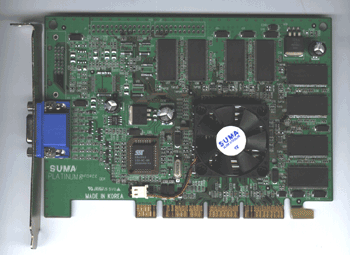The Card
Being the first 64 MB GeForce card in the lab, we were curious to see exactly what type of reference design NVIDIA delegated for use. As it turns out, the SUMA Platinum 64 MB GeForce uses essentially the same reference deign as the professionally targeted Quadro, also manufactured by NVIDIA. In terms of card structure, this leaves the Platinum 64 MB GeForce using the newly adopted AGP-Pro 25 standard to ensure that the card receives sufficient power, a feature which might scare some consumers away due to the fact that few motherboards incorporate this standard. Originally formed to alleviate some of the power consumption problems associated with higher performing video cards, it turns out that, in the Platinum 64 MB GeForce this feature is more of a cautious addition than a necessary feature. The card ran without any problems in motherboards that only used the commonly found AGP bus slot. Be wary of using this card, or any other that supports AGP-Pro, in lower quality motherboards, as it is in these systems that the card runs the risk of receiving too little power, causing anything from random freezes to an inoperable system.
In addition to sharing the same reference design as the highly priced Quadro, the SUMA Platinum 64 MB GeForce also incorporates the same RAM chips and configuration as the Quadro. The 64 MB of power comes from 6 ns Hyundai DDR SDRAM chips with an eight megabyte density. There are eight of these chips located on the front of the card to provide a total of 64 MB of raw DDR power. You may be asking yourself why Infineon chips are not used on 64 MB cards as they are on every 32 MB DDR card currently on the market. Well, as much power as there is to be gained by using the somewhat faster SGRAM chips, it seems that Infineon currently only makes the DDR SGRAM chips in densities of four megabytes per chip. This would require eight SGRAM chips on the front as well as eight SGRAM chips mounted on the back of the card, a design not supported by the reference design. While it would be possible to modify the reference design to fit such a configuration, it would take a considerable amount of time and money: two things a company wishes to avoid when attempting to win the race to the retail market.
Cooling for the card is provided by the generic low profile heatsink and fan, with one exception. Rather than go with the boring black heatsink, SUMA chose to use what appears to be polished aluminum finish, resulting in a chrome-like color. It is from this heatsink that the Platinum 64 MB GeForce gets its namesake. The heatsink is attached to the surface of the GPU via thermal glue alone. Typically, such a setup does not result in astonishing overclocking results, but in the case of the SUMA Platinum GeForce overclocking was anything but uneventful.
Sharing so many similarities with the $700 plus Quadro, one may suspect that the differences are with in the processor itself. Well, that assumption is also incorrect, for the most part. The Quadro platform, targeted at 3D graphics processionals, uses exactly the same GPU as the less expensive and less powerful GeForce. In fact, the only difference between these two platforms is that the Quadro chips are rated at a slightly higher 15 MHz over the stock GeForce setting. So, what sets the $700 plus Quadro apart from the SUMA Platinum 64 MB GeForce? Well, it seems that NVIDIA knew that they could charge more for a professional type card and leave some of these features out for the mainstream market. In order to do this, it seems that the GeForce BIOS disables some of the properties associated with the Quadro, such as enhanced support for anti-aliased points and lines as well as offering a peak triangle rate of 17 million triangles per second up from the GeForce’s 10 – 15 million triangles per second. As much as the SUMA Platinum 64 MB GeForce resembles the Quadro, it still falls a bit short. Compared to the 32 MB GeForce, the 64 MB GeForce shines, as seen in our 64 MB GeForce review.












1 Comments
View All Comments
Dr AB - Friday, May 8, 2020 - link
I have been reading these old articles for a while now, I do wonder how did they even managed to overclock cpu core & memory core separately? Wish I could knew that.